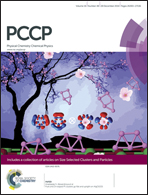Interfacial processes studied by coupling electrochemistry at the polarised liquid–liquid interface with in situ confocal Raman spectroscopy†
Abstract
Interfacial processes controlled by ion transfer voltammetry at the interface between two immiscible electrolyte solutions were studied by in situ Raman spectroscopy. Raman spectra of the interface between a 5 mM NaCl aqueous solution and 10 mM bis(triphenyl-phosphoranydieneammonium) tetrakis(4-chlorophenyl)borate in 1,2-dichloroethane were recorded at open circuit potential and at various interfacial potential differences. At open-circuit potential, Raman peaks assigned to vibrational modes of 1,2-dichloroethane are clearly visible and peaks of weak intensity are measured for the organic electrolyte ions. When a negative interfacial potential difference is applied, the intensity of the peaks of the cation of the organic electrolyte increases, confirming its transfer induced by the interfacial potential difference applied. The electrochemically assisted generation of mesoporous silica deposits was then followed by in situ confocal Raman spectroscopy. The condensation of mesoporous silica was controlled by the transfer of cetyltrimethylammonium (CTA+) ions to an aqueous phase containing hydrolysed silanes. The transfer of CTA+ at the interface was monitored in situ by confocal Raman spectroscopy, and formation of silica was observed.


 Please wait while we load your content...
Please wait while we load your content...